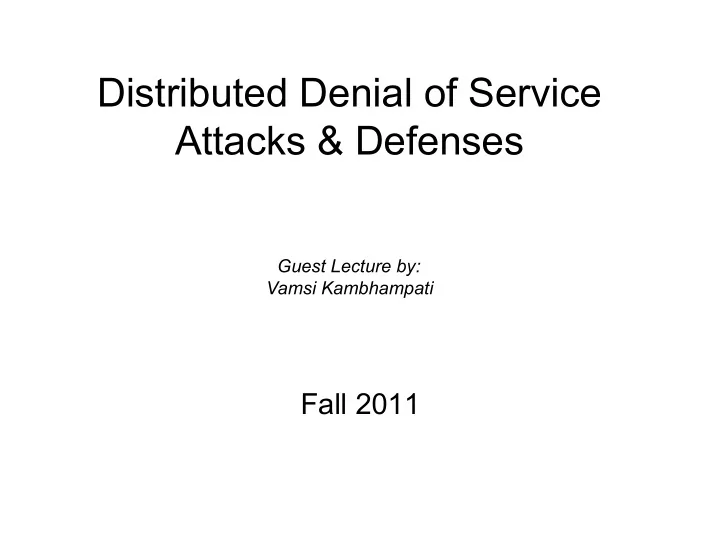

Distributed Denial of Service Attacks & Defenses Guest Lecture by: Vamsi Kambhampati Fall 2011
Distributed Denial of Service (DDoS) • Exhaust resources of a target, or the resources it depends on • Resources: CPU, Memory, Bandwidth – Legitimate clients cannot access the target server • Should we care? – For researchers: interesting problem; difficult to solve. – For others: monetary loss, infrastructure security.
Example: Bandwidth Exhaustion DDoS Attack attacker legitimate client congested router attacker destination attacker packets legitimate packets dropped also dropped
Well-behaved and misbehaving flow at router congestion at router congested router rate pkts/sec Legitimate flow time Attacker flow
Well-behaved and misbehaving traffic at router misbehaving aggregate gains throughput congested router rate well-behaved aggregate pkts/sec looses throughput time
Well-behaved and misbehaving traffic at destination misbehaving traffic does not slow down when destination requests destination well-behaved traffic slows down rate when destination requests pkts/sec time
What is the problem? • Well-behaved (i.e., legitimate) traffic follows protocol rules • Misbehaving traffic does not follow protocol rules • Internet lacks distributed enforcement of protocol rules
Defending DDoS Attacks • Filtering – Ingress filtering, Traceback, Pushback • Network capabilities – Stateless Internet flow filtering (SIFF) – Traffic validation architecture (TVA) • Proof of work – Congestion puzzles, Defense by offense • Location hiding – Secure overlay services (SOS), i3
DDoS defense with traceback routers insert edge information packet destination destination constructs path from edge information
DDoS defense with pushback pushback to contributing router identify aggregate responsible for congestion contributing router destination congested router
Network Capabilities • Fundamental change to the Internet, so that sender must have authorization from receiver to send traffic – Receiver decides what traffic it wants to receive or not receive – Network enforces receiver ’ s decision
Phase 1: Request Capabilities pre-capabilities SYN SYN SYN source destination
Pre-Capabilities • Cryptographically generated at each router R – Each router can independently verify its own pre- capability • Timestamp + Hash(SrcIP, DstIP, time, R secret ) – SrcIP, DstIP tie the capability to a flow – R secret : secret key only known to the router (the same secret is used for all pre-capabilities) • R secret changed twice per timestamp roll over
Phase 2: Authorizing a source attacker source destination SYN host-capability
Host-Capability • Cryptographically generated at the destination using pre-capabilities • Timestamp + Hash(pre-capabilities, N, T) – N is the number of packets authorized per capability – T is the time period for which the capability is valid • Routers track N, and T
Phase 3: Send Traffic BOGUS attacker source destination DATA verify verify pre-capability host-capability
Traffic Classes • Traffic classes – Request • Request packets (such as TCP SYN) – Regular • Packets with capabilities – Demoted • Packets with invalid capabilities – Legacy • Separate bandwidth allocated to regular and request traffic at each router
Denial of Capabilities (DoC) • Attacker sends flood of request packets – Legitimate requests get lost before reaching the destination • TVA solution: – Path identifiers (Pi)
Path Identifiers • Routers insider Pi bits into request packets – Kind of like pre-capabilities • Next downstream router fair-queues on the Pi bits inserted at upstream routers – Number of Pi queues = number of upstream routers
Simulation Topology 10 legitimate clients destination 10ms 10Mbps, 10ms 10ms bottleneck link colluder 1 ~ 100 attackers
Simulation Results (1) Legitimate clients are unaffected As number of attackers increase, legitimate clients Legacy traffic floods suffer
Simulation Results (2) Request traffic floods
Summary • DDoS attacks are a major threat to the Internet • Capabilities make fundamental changes to the Internet to defend DDoS attacks – Sender needs authorization from receiver to send traffic • Capabilities setup is challenging – Denial of Capability attacks
Recommend
More recommend